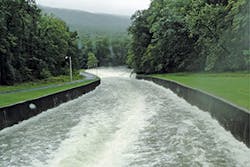Editor’s note: This article first appeared in the January/February 2016 issue of Water Efficiency.
After preparing a climate change plan for her community’s wastewater treatment plant, Carol Murray, interim director for the Manchester Department of Public Works in Manchester-by-the-Sea, MA, says if she would have done anything differently, she would have started working on the plan seven years ago.
Doing a climate change plan with the help of EPA “is one of those reality checks that really makes you stop and think,” notes Murray.
Her advice to other water and wastewater utilities: start doing climate change plans now.
“You’re a little bit behind the curve, but it’s still in advance of things hitting you,” she says. “Find out what you are facing so you are ready to start positioning yourself.”
Murray’s is one of dozens of US water and wastewater utilities preparing plans for the potential impacts from climate change. Some work with EPA; others are acting independently.
The term “climate ready” more reflects a process than any specific end state—a process resulting in the utility’s ability to withstand, respond, and recover effectively and efficiently from climate impacts, notes EPA spokesperson Robert Daguillard.
“Water sector utility climate readiness varies due to system size, type, geographic location, climate impact, and vulnerable infrastructure,” he says. “Utilities must first understand their potential future climate projections and the vulnerability of their assets to climate change impacts.”
In 2010, EPA requested the formation of a working group under the National Drinking Water Advisory Council to define what it means to be “climate ready” from the perspective of water sector utilities, including drinking water, wastewater, and stormwater.
The group delivered its findings in a January 2011 report to EPA Administrator Lisa Jackson. The findings and recommendations became the foundation of EPA’s voluntary Climate Ready Water Utilities (CRWU) initiative.
Extreme weather events, sea level rise, shifting precipitation patterns and temperature variability—all intensified by climate change—have significant water sector implications and were the driving factors for the initiative, says Daguillard.
“The EPA has the responsibility to assist water sector utilities in planning for, assessing, and adapting to climate impacts so that they can continue to fulfill their public health and environmental missions, as well as begin the process of becoming more climate-ready,” he adds.
The CRWU initiative involves a suite of tools designed to be practical and user-friendly to translate complex climate projections into accessible and actionable information for utility owners and operators. The climate science data is derived from the same climate model data and studies used for the 2014 US Global Change Research Program’s National Climate Assessment.
The agency also has reached out to thousands of water utilities through in-person training workshops and webinars.
In 2014 and 2015, EPA partnered with and assisted 23 communities in conducting a climate risk assessment using its Climate Resilience Evaluation and Awareness Tool (CREAT) and plans to assist 10 more in 2016.
“CREAT assists drinking water and wastewater utility owners and operators in understanding potential climate change impacts and in assessing the related risks at their utilities,” says Daguillard.
The tool helps utilities evaluate adaptive options to address potential climate change impacts using both traditional risk assessment and scenario-based decision making. CREAT Version 2.0 is available for free download.
